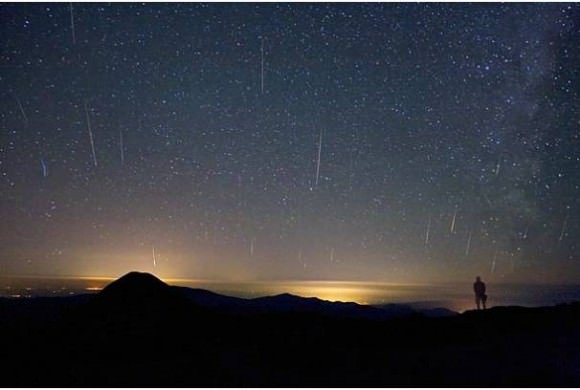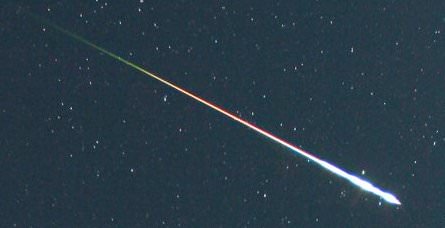[/caption]
The Draconids are coming! Will this meteor shower produce a storm of observable meteors, or just a minor squall? The Draconid Meteor Show should begin on October 8, 2011 starting at dusk (roughly 19:00 BST) and continue through the evening. Peak activity of this normally minor and quiet shower is estimated to be at 21:00 BST (20:00 UT). There seems to be a wide range of predictions for this year’s shower, but some astronomers believe there could be up to 1,000 meteors per hour, making this a meteor storm!
The Draconids or Giacobinids as they are also known, radiate from a point in the constellation of Draco the Dragon in the Northern hemisphere. In the past, notably in 1933 and 1946, the Draconids turned into a meteor storm with meteor rates of more than one every second!
So, will this year bring us a storm? Astronomers believe so as the predicted path of the Earth through the debris streams of comet 21P/Giacobini-Ziner is favorable for a major storm, similar to what has been seen in previous years. Some reports say NASA is even considering the potential risk of damage to the International Space Station and other satellites due to meteroid impacts.
Some astronomers, on the other hand, are saying this shower could be a dud, with only 5 or so meteors per hour.

Observers in the UK and Northern Europe are ideally placed to see the peak of the Draconids. Unfortunately the peak occurs in the day time for North America. There will also be a bright Moon which may drown out many but the brightest meteors, but if predictions are correct, you will still see many. You may see Draconid meteors on the 7th an the 9th also, so it is worth going out and checking the skies.

Draco is a circumpolar constellation visible all night from northern latitudes.
There is no skill or even astronomical knowledge needed to enjoy meteor showers. All you need is to be comfortable, away from bright lights and your eyes. Sit back on a recliner or garden chair and fill your gaze with sky as meteors can appear anywhere as they radiate from the constellation of Draco. For more info on how to enjoy meteor showers visit meteorwatch.org
So what will you see? Draconid meteors are usually slow and bright streaks of light, but if you look away, you can still miss them so keep your gaze on the sky.
There are no guarantees of a meteor storm or even a good meteor shower as these phenomena can be very unpredictable, but the only way to find out is to go outside and look up.
If predictions are correct, you could be in for a spectacular treat and something truly memorable, so don’t miss it. Even if it is cloudy, you can listen to the meteor shower or you can watch as they enter Earths atmosphere
For more information on the Draconids, see the International Meteor Organization’s post on this year’s shower.
Good Luck!



Time to get the radio tuned up to the Air Force Space Surveillance System (NAVSPASUR) frequencies… Could be interesting – especially since it peaks during the day here…
I have seen more than normal activity in the northern sky’s I am in Pennsylvania metro area, lehigh valley but a short drive to some mountainous area’s fringe of seeing mag 5.5 stars. About a week ago got a small burst and seen about 30 in 2 hours between peeks through my scope. seems to have slowed as seen about 15 but so much cloud cover not worth the drive. Hopeing for a good weekend, but the moon is evil lately seems to be hitting all the peaks with a full or nearly so. ;-(
Ya know, the Triffids arrived here on Earth the same way: http://en.wikipedia.org/wiki/The_Day_of_the_Triffids_%28film%29
Just sayin……
One of my favorite books. 😉
I’m hoping I’ll be able to see something of these. If it looks good on my way home from work (near midnight CST) I’ll definitely have my son out to watch as well.
watch for an hour first, if ya go blind, do not bring the boy out!
Good point. 🙂
Just saw huge meteor (?) western sky, 8:06 pm Livonia, Michigan (just outside of Detroit) Largest and lowest object I’ve ever seen. Burned for about 1.5 – 2 seconds. Not sure what I saw, but it was awesome!
I saw that same one looking west from Cambridge Ontario. It was the brightest I’ve ever seen. Seemed to be moving slower than usual too.
Someone said it could have been debris from a Russian satellite as heard on WJR radio. I’ll have to check into this. Glad to know somebody else witnessed it. Quite spectacular.
This will be a very close call i pray it is only that. Discovered on December 28, 2005 by Robert McMillan
of the Spacewatch Program A potentially hazardous Asteroid known as 2005 YU55. This Asteroid some what
Large 400 meter-sized type – C, will pass by the Earth right between our moon and Earth.
On November 8, 2011.
The people on Earth have not seen a Asteroid of this size in advance. One this big Has not impacted Earth
in over at least 4 thousand years. Most Objects that have a diameters over 45 meters or 147.637 ft
strike the Earth approximately once every thousand years or so. Lying flat everything for hundreds of miles.
Like the TUNGUSKA 1908 SIBERIA, RUSSIA CRASH OR Tunguska Explosion. This one did not even hit the Earth with
its full Impact, it burst high in the air above the ground plowing it apart into many smaller parts. Making
thousands of very deep holes in the Russian forests. Many of them in dense forest far from any roads or towns.
One 400 Meters 1,312.3 ft in diameter like this one would if impacted Earth on land would darken all of
the Earth not for just days but much longer. It would change the weather not seen on Earth in over thousands
of years a massive climate change to say the least.
The World and NASA will watch this one very closely.
The Lord’s Little Helper
Paul Felix Schott